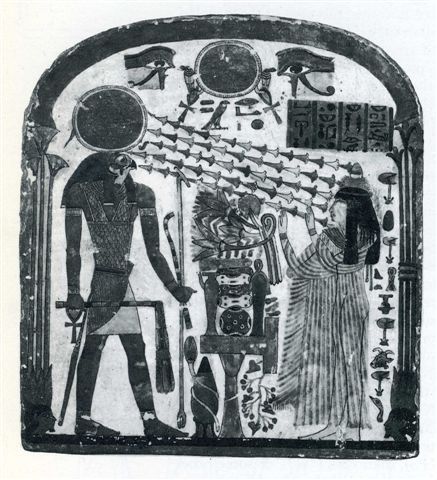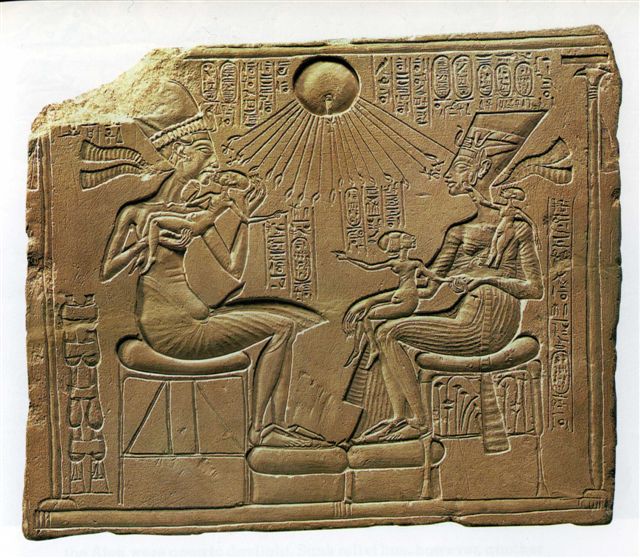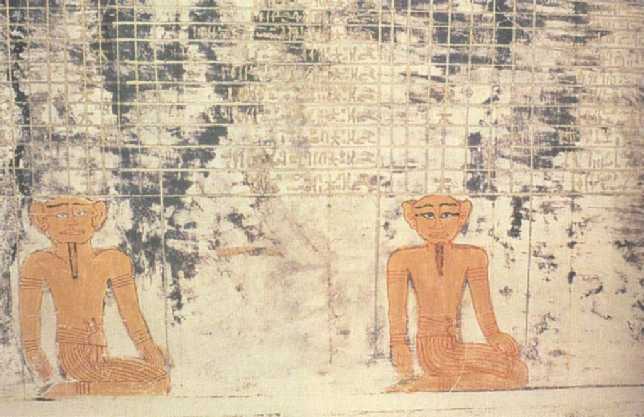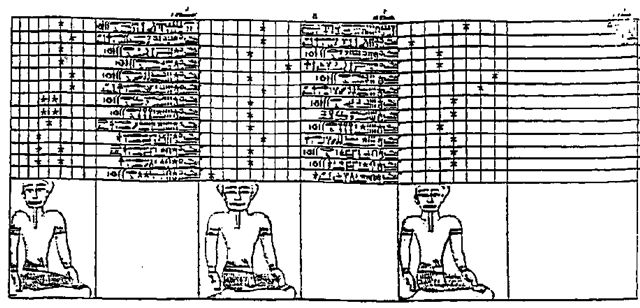The ancient Egyptians' religion drew from many sources. As an agrarian people,
there were many deities that were bovine, such as the Apis Bull, associated with fertility, and aquatic, such as Hapi
the Nile god. Their celestial deities and the correspondence between their life and the sky is pervasive.
It's hard to say whether Egyptians were more sky-oriented than other ancient religions. Actually, it appears that cosmology was an important feature
of ancient religions; our ancestors' religions drew from the sky for their spirituality. It would be hard to find an
ancient people who did not feel a spiritual connection with the sky; why?
People of the distant past were in a closer relationship to their natural surroundings than we
generally are today. The seasons, stellar and planetary movements, weather patterns, even risings and settings of
the Sun and changes in the Moon's cycles were more remarkable to them. Geographical features such as the lay of the land, the type
of fauna, rivers, streams, oceans, along with dust, rain and wind storms were held in awe. These phenomena had vital effects on their
lives and had to be reckoned with. Their origins and character were mysterious and often their occurrence were unforeseen.
| SUN DISK WITH FLORAL RAYS
Horus as the Sun God is shooting rays to Tentperet
in her funeral stele; Late Period. From Reading Egyptian Art
By Richard H. Wilkinson

|
Humanity held nature in awe but also in close observation. The movements of the Sun and Moon, stars, planets, signs, and later, of comets,
became known. Connections were made between earthly changes and celestial cycles. Layers of those cycles were seen to be
moving simultaneously: the "Stars that never die" -- the Egyptians' phrase for the circumpolar stars; the stars that rise and set; the planets; the phases of the Moon; and the Sun's day and
night reincarnations.
Many researchers cite the Mesopotamians and the Hellenistic period as laying the foundations for astrology and astronomy.
Along with those contributions, the Egyptian sky and geography has a unique character that shaped modern astrological concepts immensely and serves to add to our understandings of astrology's orgins. Egypt is where Hellenistic culture flourished,
with Alexandria as its major city during that period, and the first horoscopes were erected.
There are even indications that Alexander the Great brought Egyptian concepts to India, which were joined with indigenous celestial traditions there.
The use of the decans as in Egypt is an example.
The symbolism of the Egyptian religion involves their deification of the wonderment of nature, using human, animal, plant, and other entities of the Egyptian environment as symbols whose characteristics were associated with natural phenomena and personal
experience, and the subjective realm as implied by the passage of the Sun in the night. Symbols were combined, creating a tapestry of images and stories that became complex epics. Rituals were developed that involved music, sculpture,
prayers, and dance. Those representations gave birth to our arts - temples evolved into museums, prayers to poetry, and according to Herodotus, Egyptian ritual became
Greek drama, - the arts were spawned from our deference and adoration of the divine in nature.
In ancient Egypt as in modern Egypt, there was rarely rain; a cloud may resemble a light brush stroke on a blue field. And the Sun.. there are not many places
that will offer the contrast between night and day as in Egypt, especially during summer with the intense heat there! It is easy to see how the role of the Sun played
such a central role in Egyptian religion, as did the the "devouring" of the Sun at the end of the day. At one point, Egypt became the birthplace of monotheism, and the symbol for that diety was
the Aten, the solar disk. The Aten did not have gender attached to it as do the monotheistic concepts that followed in Judaism, Christianity, and Islam. The Aten
was comparatively abstract, with rays in the form of hands extending the Ankh, "Eternal Life", to the living. The Moon also played a role, and the Sun and Moon were called "The two eyes of Re", the Moon being the left eye.
|
Limestone, circa 1345 BC; Agyptisches Museum, Berlin |
THE ATEN DISK BESTOWING LIFE ON PHARAOH AKHENATEN, QUEEN NEFERTITI
AND THREE OF THEIR DAUGHTERS

|
The Imiunut, literally "One who is in the hour", was the astronomer priest who observed and recorded the celestial movements. Science, religion, magic, and even politics
were fused together in the practices of the priesthood of ancient Egypt. It would be inaccurate to call an imiunut an astrologer or astronomer. But could he have been both? |
THE IMIUNUT

|
It's possible that no other religion had as many deities as that of the Egyptians. As far as the stellar deities, there was one for each star, the hour, planet, and in some cases a deity could have a different appellation to describe a different form. For example, Heru, or Horus, the solar god but also be a sky god that represents a planet; some of those forms are shown in the section on planets below.
It is from the Egyptians that the concept of the Ascending sign comes from. Specific deities were associated with the risings and settings of stars for hours in the night. It is hard to imagine that they would casually deify an hour without that hour having some kind of character or significance related to it. Thus, when the imiunut observed the rising of spdt  (Sirius),
that hour would have that meaning. spdt was associated with Isis, and that is not a connection that would have been without importance. "The hour of Isis has begun" or, "The hour of Isis has culiminated." Might have been a gong or other audio notation to announce a star's rising or culmination? While that may seem like an assumption that's hard to prove, the ancient priests fused magic, science, ritual, into their practices, unlike
today's astronomers, who select names for newly discovered stars, comets, and other bodies
and phenomena in a comparatively arbitrary manner. (Sirius),
that hour would have that meaning. spdt was associated with Isis, and that is not a connection that would have been without importance. "The hour of Isis has begun" or, "The hour of Isis has culiminated." Might have been a gong or other audio notation to announce a star's rising or culmination? While that may seem like an assumption that's hard to prove, the ancient priests fused magic, science, ritual, into their practices, unlike
today's astronomers, who select names for newly discovered stars, comets, and other bodies
and phenomena in a comparatively arbitrary manner.
|
THE STARS
In Egyptian Cosmology the stars - sba, written  , and , and
 , and plural as sba.w , and plural as sba.w  , were more
carefully observed and played a more significant role in their cosmology than the planets or the signs. 36 stars, later called the decans by the Greeks because they were associated with ten day periods gave 36 "weeks",
three for each month. The character for "Star" , were more
carefully observed and played a more significant role in their cosmology than the planets or the signs. 36 stars, later called the decans by the Greeks because they were associated with ten day periods gave 36 "weeks",
three for each month. The character for "Star"  , had interesting inclusions in many words: door , had interesting inclusions in many words: door  ; student ; student  ;
teach (verb) ;
teach (verb)  ; and for a surveying instrument ; and for a surveying instrument  , which is interesting, since it shows how stars were utilized for orienting the construction of temples
and other important structures. , which is interesting, since it shows how stars were utilized for orienting the construction of temples
and other important structures.
|
Throughout Egypt's long history, celestial obesrvations were made and some detailed records have survived. Because there is such a long record, certain terms, concepts, and practices changed. For example, the heliacal rising of a star was used to gage the time of night and the advance of
the ten day "week" of the decans. (The helical rising occurs when a body, whether it be the Moon, planet or star becomes visible at the dawn for a flash before disappearing. Each successive night it rises further ahead of the Sun and is visible in the night sky longer. The decanal
stars advanced that way for ten days until the next star had its heliacal rising.) The months were also gaged this way just before dawn, but in opposite fashion: the Egyptian month began on the day the Moon disappeared i.e. at New Moon and not at its first appearance; the only people who also begin their lunar months this way are the Masai. This
similarity is an indication of a possible early tie with Egypt's nomadic ancestors who were known to winter further south and east.
Later, as evidenced by the "Star Clocks" of the Ramesside period, the culmination of a decanal star was used. It's possible
that the stars' -particularly Serius's, which was used to predict the Nile's flooding and thus the New Year- movements in relation to the Sun and therefore the seasons had changed from their original confluence. This would make the culmination of a star more accurate.
The following is a star map that shows the movements of stars in the sky for a particular period:
|
Ramesside Star Clocks, so called because they were painted on the inside of coffins during the Ramesside period of the XXth Dynasty, suggest how stars were observed at that time. It is believed that an imiunut's assisstant sat
in a position similar to this and the stars' positions were recorded in relation to where he sat. |
"RAMESSIDE" STAR CLOCK

|
This method's accurracy has been criticized by some egyptologists because the assistant's position would not have been consistent every night, and may be off by a few degrees or minutes. On the other hand, it's possible that the imiunut and his assistant may have been
much more precise in their sitting and viewing. That criticism is assuming a lot from what might have been an idealistic rendering of what was likely a rigorous scientific practice. Egyptian art can be misleading to appear that it was always stylistic and lacked realism. However, there are many portraits of individuals that are striking in their precision. The function of a work determined its form, and there were canons that went unchanged for years. One only has to look at the exactitude of the pyramids, and the orientation of temples to be reminded of how careful their measuring and observations could be.
|
This image shows the details of the star clock more clearly. The top line gives the month and its day, followed by the hour, the decanal star's name, and the star's postion for the hour is drawn above the assistant. |
AN OUTLINE OF A RAMESSIDE STAR CLOCK

|
|
THE PLANETS
The planets did not figure into the Egyptian religion as prominently as the Sun, Moon and stars. While the planets were important, it is possible that the stars' more consistent movements, such as the circumpolar stars which were always present in the night sky and the
decan stars, which rose and set in consistent annual cycles. This may be because they were more functional in determining the cycles that were of vital interest to them, such as Sirius's heliacal rising, which coincided with the Nile River's flooding. In addition, the Egyptians' preference for stability
over chaos would also give added importance to the stars. The emphasis of planets and signs over the stars evolved during the Hellenistic period in Egypt. Nevertheless, the planets were important, and there are mention of them and their influences. An example is mention of one part of
the Mercury cycle as having a "Set" characteristic in the tomb of Rameses VI. Also, in the same tomb, Venus is likened to a phoenix; that tomb will need more studying, for its many stellar diagrammed ceilings. Here are some of the hieroglyphs for the Sun, Moon, and planets: For the Sun,  , and , and  .
The first is how the word for Sun would be written, and the second is for the Sun as the deity Re. .
The first is how the word for Sun would be written, and the second is for the Sun as the deity Re.  , pronounced something like "eeayh" and , pronounced something like "eeayh" and  is the sign for the Moon;
and was also used to signify "Month". The symbol for the diety (Djhuti) Thoth, who was associated with the Moon, was also used. Mercury was is the sign for the Moon;
and was also used to signify "Month". The symbol for the diety (Djhuti) Thoth, who was associated with the Moon, was also used. Mercury was  , Sbg. Venus was Beh, , Sbg. Venus was Beh,  ,
a Heron, which was associated with the innundation of the Nile River. This bird was seen nesting during that time, and its connection to Venus isn't understood. However, if I would take the liberty of applying Venus's link with wealth, and endowment, that time of year in Egypt would be consistent with
Venus. The above reference to a phoenix, would also relate to a rejuvenation of resource. Mars, ,
a Heron, which was associated with the innundation of the Nile River. This bird was seen nesting during that time, and its connection to Venus isn't understood. However, if I would take the liberty of applying Venus's link with wealth, and endowment, that time of year in Egypt would be consistent with
Venus. The above reference to a phoenix, would also relate to a rejuvenation of resource. Mars,  , is Hr-akhti, "Heru [Horus} of the two Horizons". Note the planet's connection with Heru (Horus), the solar diety, and his association with the east and west. Jupiter, , is Hr-akhti, "Heru [Horus} of the two Horizons". Note the planet's connection with Heru (Horus), the solar diety, and his association with the east and west. Jupiter,  ,
Hr-wpsh-tawi, "Heru, Opener of the Lands". Again, we have to intuate what that could mean. How would Jupiter open lands? Would Jupiter's expansive influences be the source of this appelation? Saturn: ,
Hr-wpsh-tawi, "Heru, Opener of the Lands". Again, we have to intuate what that could mean. How would Jupiter open lands? Would Jupiter's expansive influences be the source of this appelation? Saturn:  , "Heru, Bull of the Sky". After Jupiter and
Venus, Saturn is the second brightest stellar body, and when visible, would be in the sky longer than Venus, as Jupiter is. There were other names for the planets, such as "Heru of the Southern Sky" for Jupiter, and for Mars, the intriguing "The Planet that moved onwards and retreated" Could that refer to Mars
moving direct and then retrograde? For Mars there is also the descriptive "The Red Heru". These last two were presented by E.A. Wallis Budge, in his An Egyptian Hieroglyphic Dictionary. He has not always been reliable, and unless another source confirms his work, I would be careful. , "Heru, Bull of the Sky". After Jupiter and
Venus, Saturn is the second brightest stellar body, and when visible, would be in the sky longer than Venus, as Jupiter is. There were other names for the planets, such as "Heru of the Southern Sky" for Jupiter, and for Mars, the intriguing "The Planet that moved onwards and retreated" Could that refer to Mars
moving direct and then retrograde? For Mars there is also the descriptive "The Red Heru". These last two were presented by E.A. Wallis Budge, in his An Egyptian Hieroglyphic Dictionary. He has not always been reliable, and unless another source confirms his work, I would be careful.
It must be
remembered that Egypt had a long history, and the various names for stellar bodies may be indications of sightings that were made at different times and sometimes correspond to specific events. For example Jupiter, as are the other planets, is always seen in the south, so the appellation "Heru of the Southern Sky" may
refer to a time when Jupiter was particularly bright, or made a conjunction with another stellar body that enhanced its brightness.
|
A detail from Senenmut's tomb ceiling. He was the Vizier (Ch-ah-ty) of the female Pharaoh Hathshepsut. |
LUNAR/HOUR CIRCLES, 2008

|
The twelve circles in this section represent the 12 Lunar months, with each circle divided by 24, for the hours of the day. This may be the first use of a circle divided into
sections representing hours. The Egyptians, with their observance of the heliacal risings of stars, and the deities associated with those hours gave astrology the notion of the ascending sign. Judging from these images, the Egyptian origins of
the twelve houses in astrology is likely.
Even if one doesn't see the value of astrology, it should be regarded as a living depository of ancient cosmological concepts and practices. By understanding the evolution of the art/science of astrology,
it is possible to understand the evolution of humanity's ideas about itself in terms of its celestial, earthly, and psychological existance.
The points discussed here are not meant to be complete answers to the complex study that Egyptian religion requires. And let's not get into the complexity of the Egyptian calendar, which is scientific, symbolic, multi-layered, and completely
misunderstood by most people! But it is instructional for the many ways that time occurs, and that can be conceived.
What we can see is that the Egyptians tied their religion with the stars as they did life. Chonsu, one of the deities that was connected with the Moon, was seen as the god of chronology, a counsellor and healer. The Moon, they thought, "influenced" growth
for good and evil. This connection between celestial cycles, deities, and everyday life is similar to what astrology is. An astrologer blends many entities (planets, signs, houses), their movements, and interprets or sums up what they mean in combination.
This art and science is ancient, and probably predates literate societies. Our relationship to such cycles is obscured by the buildings we live in, the lights that compete with the night sky, and many of us regard time as a schedule, a page on a wall, not
what is the character of an hour, what is this moment's essence?
|
|
|
|